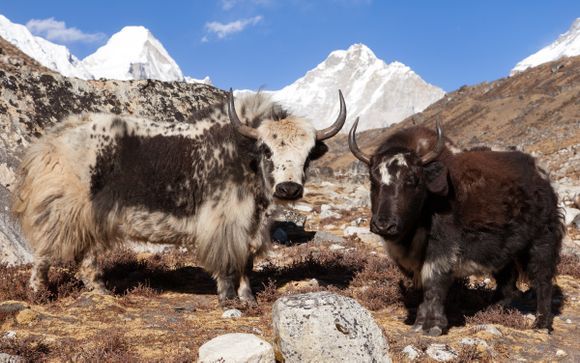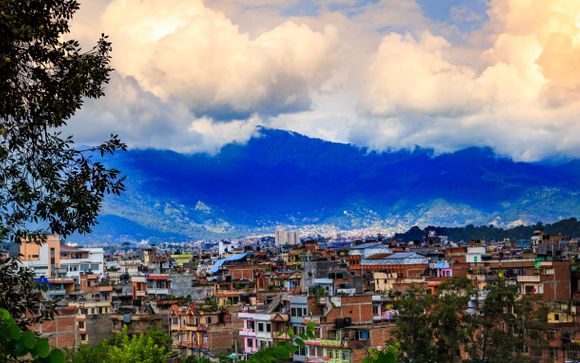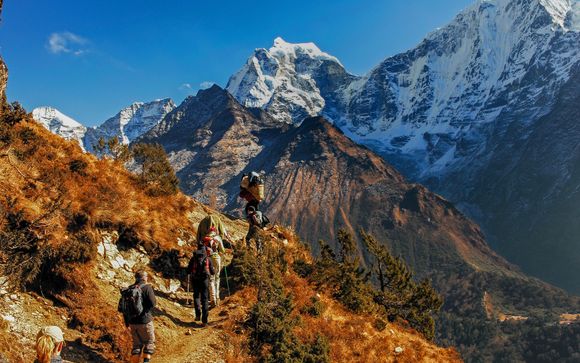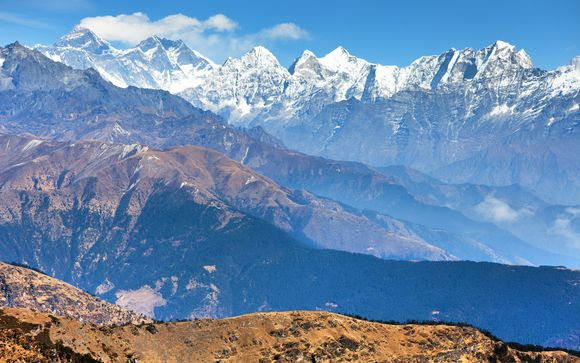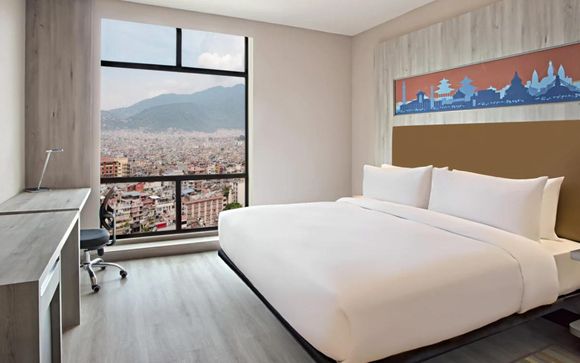We Love —
- Admiring the sunrise over the Everest Himalayan Range during the Pikey Peak trek in the Solukhumbu Region.
- Visiting ancient Tibetan monasteries and Buddhist temples in Kathmandu.
- Having a fully organised trek complete with guides, porters and assistants - leaving you free to enjoy the incredible view!
New Voyage Privé —
Carefully selected by our experts especially for you
Your Itinerary In Brief —
Pikey Peak is a one of the tallest 'Hills' in the Solukhumbu region, a newly popular trekking destination. This peak offers a majestic view of the Everest Himalayan Range.
The trail passes through beautiful settlements; visit the ancient Buddhist Monastery of Thupten Chholing and enjoy the unique Sherpa culture.
The Pikey Danda (hill in Nepali) is most popular for its sunrise and sunset views with views of seven 8000-metre peaks. The trekking is organized in teahouses.
Our offer:
Day 1: Arrive in Kathmandu
Day 2: Kathmandu
Day 3: Ktahmandu - Dhap
Day 4: Jhapre
Day 5: Pikey Peak Base Camp
Day 6: Jase Bhanjyang
Day 7: Thupten Choling Monastery
Day 8: Phaplu
Day 9: Kathmandu
Day 10: Departure from Kathmandu
Your Itinerary In Detail —
Day 1: Arrive in Kathmandu (1350 m)
Arrive in Kathmandu, meet and transfer to hotel.
Check in at the hotel and after refreshment visit Patan, the old Newar city. See the historic Durbar Square, the Golden Gate, the sky-piercing temple of Taleju and the statue of Yogendra Malla. You'll also see Krishna Mandir, Sati Temple, and Hiranya Varna Mahabiar (the golden temple). Visit Mahabouddha with old carved wooden windows, curio shops and bazaars lining the streets.
Head to Tibetan Singing Bowl & Healing Center, a local shop that specializes in sound healing therapy from handmade Tibetan bowls. The vibrations of the bowls are said to cure headaches, back pain, stress and insomnia! The quick sound healing session takes less than 5 minutes and is free.
Overnight at hotel.
DAY 2: Kathmandu (1350 m)
Kathmandu Durbar Square is located in the heart of the old city of Kathmandu. There are around 50 temples in the vicinity. In this tour, we visit the 17th Century Durbar complex, Hanuman Dhoka, Paravati temple, great Bell and Drum, Bhairav and Taleju Temple. All around the splendour of historical monuments is the hustle and bustle of the marketplace. Vegetable vendors, trees of flutes, salesmen with their wares displayed on their person, souvenir hawkers, and street shop selling imported good clamour for attention. Tucked away in a quiet corner, you'll find the glittering bead market for custom made bead necklaces.
The “Hippie Trail”, or Bahal Tour follows the areas where hippies in the '50s lived. Walk from Thaithy chowk to Kathmandu Durbar Square. Be aware, that the streets are narrow, so mind the vehicles and people walking around you.
Swoyambhunath (UNESCO World Heritage Site) - Swoyambhunath literally means 'Self-Existent One.' Swoyambhunath is believed to have been established more than 2,500 years ago. An inscription dated 460 A.D. states that the construction was carried out by King Manadeva. By the thirteenth century, Swoyambhunath had developed into an important Buddhist learning site. It is also known as the Monkey Temple, as there are holy monkeys living in parts of the temple in the North West. Swayambhunath occupies a central position; it is probably the most sacred among Buddhist Pilgrimage sites.
Bouddhanath, which was built in the 14th century, is possibly the world’s largest Buddhist Stupa. The stupa has become one of the most important centres of Tibetan Buddhism. The construction of the stupa serves as a three dimension which shows the Buddha’s path towards enlightenment. The base of the stupa is surrounded by 108 small images of the Dhyani Buddha Amitabha and prayer wheels. Around the stupa a number of monasteries have sprung up number of the different sects of Tibetan Buddhism including one (on the west side of the stupa) that houses an enormous seated statue of Maitreya Buddha splendidly adorned.
Participate in a Buddhist Ceremony in one of the monasteries in Boudha where monks perform their rituals, chanting Buddhist mantras, and praying for good health and prosperity. At the end of the ceremony, monks offer blessings and food.
Overnight at hotel.
Day 3: Drive from Kathmandu to Dhap (2900 m)
Leave Kathmandu in the early morning for the long drive to Dhap. Follow a Japanese-built road through the mountains to the Sun Kosi river. Follow the river down for a long time before crossing it and climbing up to Okhaldhunga. It’s about a 3-hour drive from the trailhead at Dhap. The road from Okhaldhunga is a good blacktop road that climbs from 1560m at Okhaldhunga up to 2800m at Dhap.
Drive Duration: 8 to 9 hours.
Overnight at hotel.
DAY 4: JHAPRE (2812 m)
Early morning walk for 25 minutes to viewpoint for sunrise and to see mountain views (Dughkunda, Mera Peak, Lotse, Cho Yo and Everest). There is a temple for both Hinduism and Buddhism. After enjoying the magnificent views, we can eat breakfast and get ready for the walk to Jhapre.
After two hours of gradual/gentle downhill walking through the rhododendron and pine forest, stop at the first village, Siganay, for a short tea break.
Then continue for three more hours uphill and gentle walk to Jhapra. It has a monastery attached to the guesthouse. Enjoy the sunrise and mountain views (Dudhkunda, Pongday, Makalu, Mera Peak, Cho Yu, Everest, Tsumsherko and Kanchanjunga range).
Trek Duration: 5 Hours
Overnight at Lodge.
Day 5: Pikey Peak Base Camp (3640m)
After enjoying the sunrise, mountain views and breakfast, start the trek for 2.5 hours gradual uphill through rhododendron and pine forest. It takes you to Bulbule where we can have a short break for tea.
Then 45 minutes gradual uphill and gentle walk to reach Lamachay village and where we can stop for lunch. After crossing stupa, there's a further zigzag/steep climb for an hour through the rhododendron and pine forest. Then gently and gradually uphill we reach the base camp. It is interesting to visit the cheese factory. Watch the sunset and see Langtang Peak, Ganesh Himal, Manaslu and the Annapurna mountains.
Trek Duration: 6-7 hours.
Overnight at Lodge.
DAY 6: JASE BHANJANG (3549m)
Early morning for an hour and half hour, steep climb, reach Pikey Peak for sunrise and view panoramic mountain views from Manaslu to Kanchanjunga range (Dhaulagiri, Annapurna I, Manaslu, Ganesh Himal, Langtang, Pongday, Dudhkunda, Everest, Cho Yu, Thamserko, Mera Peak, Makalu and Kanchanjunga. Out of the 14 highest mountains above 8000 meters peak in the world, we can view 7 highest peaks from Pikey Peak (4067 m).
Enjoy sunrise, panoramic mountain views, and villages around and can relax for a couple of hours. Slowly we can walk steep downhill for two hours, passing by jasmine flowers (high mountain incense).
Then reach Jase Bhanjyang. It is located in the valley. There are only two teahouses. Spend the night there. The teahouses have cows and yaks, so you can observe the making of hard and soft cheese, buttermilk, butter and yogurt.
Trek Duration: 4 ½ - 5 hours.
Overnight at Lodge / home stay.
Day 7: Thupten Choling Monastery
At first 30 minutes steep climb and an hour gradual uphill take us to the top of 3900m then steep and gradual downhill for another 1.5 hours follow by 2 hours gentle walk reach us to Junbesi village (2700m).
It is a Sherpa village where we can pass by several choten and stupas, Mopung village, agricultural fields and a river for 2 hours further gradual uphill reach us to the Thupten Choling Monastery. We can be a part of the monastery family to observe chanting at the monastery, eating monastery meal and can sleep at the monastery area. It is very interesting the nuns and monks can chant and do worship together at the monastery, this is the unique of this monastery. It is 85 years old monastery. About 300 nuns and 100 monks live there.
Trek Duration: 6-7 Hours
Overnight at Lodge.
DAY 8: PHAPLU (2469 m)
We follow the road though, hardly see any vehicles, gentle walk along the river and the beautiful views of the villages other side of the walk. After 4 hours gentle walk , climb gradual uphill for 30 minutes to Phaplu. Phaplu is a small Sherpa village where we can see the airport.
Trek Duration: 5 Hours
Overnight at Lodge
DAY 9: DRIVE TO KATHMANDU
Breakfast at hotel. Board the jeep and drive back to Kathmandu
Drive Duration: 7 Hours
Arrive and check in at the hotel
Overnight at hotel.
DAY 10: DEPARTURE
Breakfast at the hotel. Transfer to the International airport to connect the flight to onward destination.
Your Hotels —
HAND-PICKED JUST FOR YOU
During your stay, you'll be accommodated in the following 4* or 5* hotels, depending on your chosen offer:
Kathmandu: Dom Himalaya Hotel 4* or Aloft Kathmandu Thamel 5*
Trek: Tea House
Your Dining Choices
This offer is based on a Bed and Breakfast stay in Kathmandu. During the trek, all meals will be provided (breakfast, lunch and dinner), along with one hot drink (tea or coffee) after meals. Tea and biscuits in the afternoon will be provided on reaching the lodge after the trek.
Your Optional Excursions —
Optional Himalayan Mountain Flight on Day 2 or 3
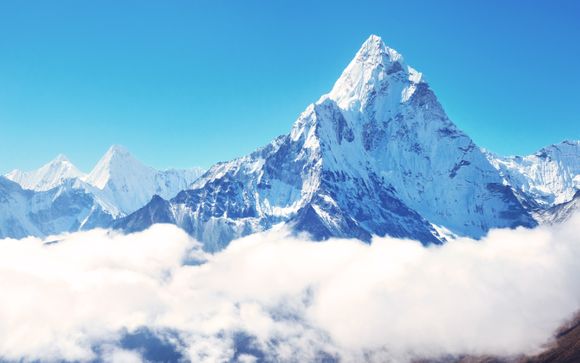
The mountain flight offers the closest possible aerial views of Mt. Everest, Kanchanjunga and the Tibetan Plateau. Twice the size of the Alps, their sheer immensity is mind-blowing. The 45-minute flight offers an incredible panorama, and you can take a photograph of the world’s highest mountain from the cockpit.
Everest Experience by Plane (full details):
The flight usually lasts between 50 minutes and an hour. The planes take off either from TIA, Kathmandu. During the flight, you will catch a glimpse of 20 of the highest peaks to the East of Nepal, starting with the Langtang Lirung peak which is the closest to Kathmandu.
Then we'll move towards Mt. Everest in the East and finally fly to Chamlang peak. From there, the plane takes a turn and the passengers get a second look at the view while we make our way back to Kathmandu.
The mountain flight not only allows you to enjoy fantastic views but also helps you understand the geography of Nepal. Although mountain flights are relatively new, they're very popular because of the natural beauty that you can witness. Buddha Air provides mountain flights every day, early in the mornings, when the Himalayas views are the best!
- Flight starts at 6:00 am, early in the morning
- Mt. Everest 20 miles from your window
- Witness fantastic Himalayan peaks, lakes and glaciers
- 50-minute flight with guaranteed window seat
While on board, you will receive a 'Himalayan Peaks' map from our flight attendant. This map contains information about the different peaks you'll see during the mountain flight. You'll also get a briefing from our flight attendant of the visible mountains. You'll see stunningly beautiful mountains that are above 8000 meters such as Cho-Oyu, Shisha Pangma, Mt. Everest and Lhotse from a guaranteed window seat on the aircraft.
To commemorate your once-in-a-lifetime experience to the top of the world, we give out a personalized Everest Experience certificate to each passenger after the completion of the flight.
Your Journey —
Flights:
You may choose from Economy, Premium or Business class flights on sectors that they operate, at the next stage of the booking process. The flights included are with either a scheduled or no-frills airline and are subject to live availability and prices can change. You can choose your preferred departure times during the booking process. Please select your flight options carefully as departure and arrival airports may differ.
Transfers:
Tour transport and inter-hotel transfers are included as per your itinerary.
Your Destination —
Kathmandu
The magic of the Himalayas is condensed in Kathmandu. The capital of Nepal is a city with an undeniable charm that envelops its visitors, offering them unique memories. You will feel that time flies by on your walks through Kathmandu. In this city, the aroma of tradition, rich culture, and the lights of progressive modernization are mixed in a unique way.
Kathmandu is located in the centre of a valley where up to seven Unesco World Heritage sites are counted. These sites offer you the opportunity to observe, first-hand, the complex geometry, grandeur, and majesty of Nepalese art and architecture and the respectful simplicity of the two dominant religions in Nepal: Hinduism and Buddhism. Kathmandu is worth it!

